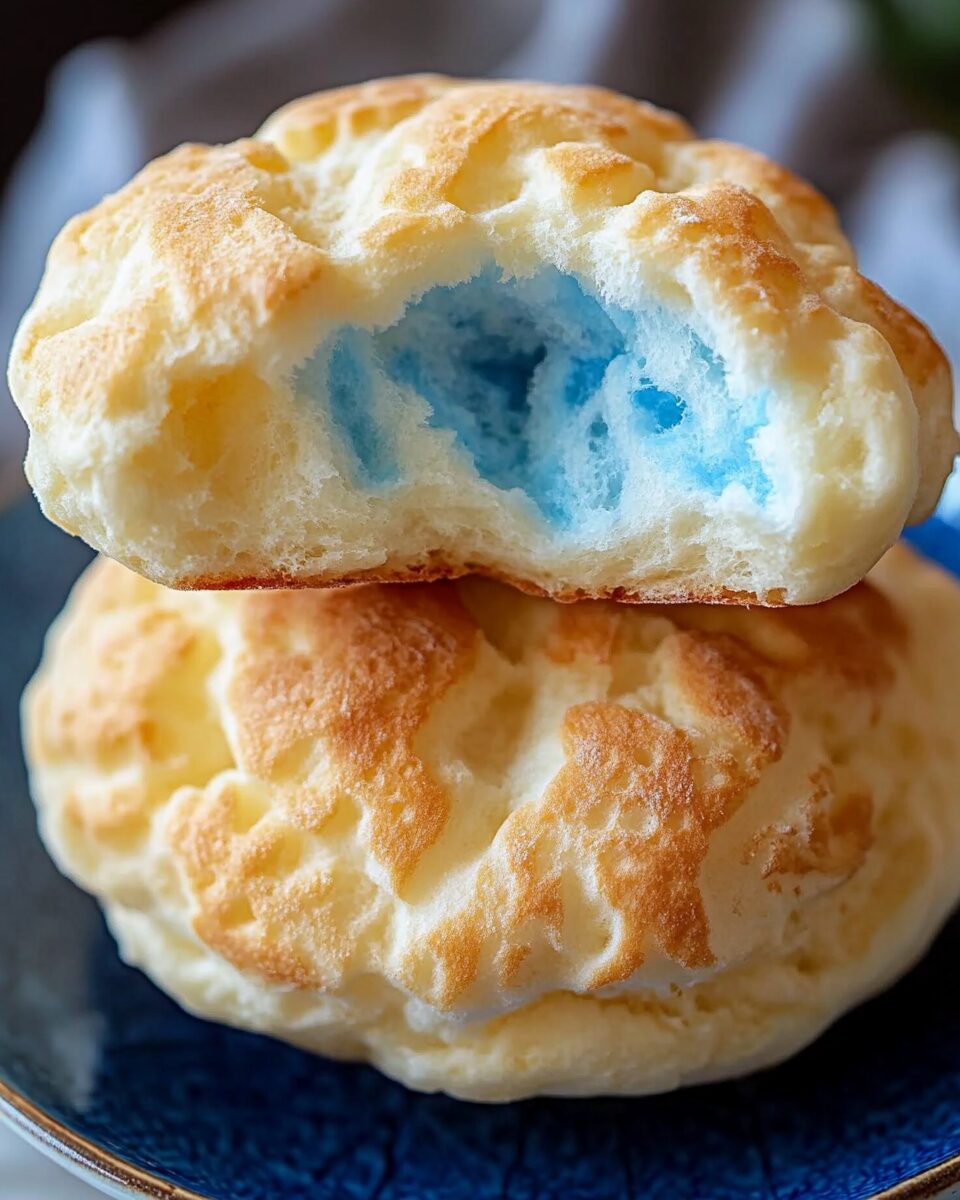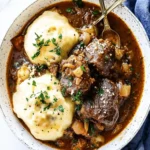Cloud bread is a light, airy bread alternative that has gained popularity for its fluffy texture and simple preparation. Made with just three basic ingredients, it’s a delightful treat that resembles a soft, pillowy cloud.
FULL RECIPE:
Ingredients
- 3 egg whites
- 30 grams white sugar (approximately 2-1/2 tablespoons)
- 10 grams corn starch (approximately 1 tablespoon)
Directions
- Preheat the Oven: Set your oven to 300°F (150°C).
- Prepare the Egg Whites: In a clean bowl, whisk the egg whites until they become frothy.
- Add Sugar and Corn Starch: Gradually add the white sugar and corn starch to the egg whites, continuing to whisk until the mixture forms stiff peaks.
- Shape the Mixture: Spoon the mixture onto a baking sheet lined with parchment paper, forming a dome shape.
- Bake: Place the baking sheet in the preheated oven and bake for approximately 25 minutes, or until the cloud bread is lightly golden.
- Cool and Serve: Remove from the oven, allow it to cool slightly, then enjoy your homemade cloud bread.
Nutrition Facts
- Total Fat: 3g (4%)
- Saturated Fat: 1.5g (8%)
- Cholesterol: 60mg (20%)
- Sodium: 80mg (3%)
- Total Carbohydrates: 0g (0%)
- Dietary Fiber: 0g (0%)
- Sugars: 0g
- Protein: 2g
History and Popularity of Cloud Bread
Cloud bread has gained significant popularity in recent years, particularly among those following low-carb, gluten-free, or keto diets. While the viral trend started on social media platforms like TikTok and Instagram, cloud bread has actually been around for decades. The original version of this recipe dates back to the 1970s when it was part of the Atkins diet. Since then, variations of this bread have been used as a substitute for traditional wheat-based bread in a variety of diets. One of the main reasons cloud bread has become so popular is its unique texture and simplicity. Unlike traditional bread, which requires flour, yeast, and a long proofing process, cloud bread comes together quickly with just a few basic ingredients. This makes it an attractive option for those looking for a quick and easy alternative to bread without the added carbs and gluten.
Health Benefits of Cloud Bread
Cloud bread is considered a healthier alternative to traditional bread, especially for those on specialized diets. It is naturally gluten-free, making it an excellent choice for people with gluten intolerance or celiac disease. Since it contains no flour, it also has a lower carbohydrate content, making it ideal for those following low-carb, keto, or diabetic-friendly diets. Another advantage of cloud bread is its high protein content. Made primarily from egg whites, it provides a source of high-quality protein that helps with muscle repair and growth. The inclusion of egg whites also means it contains essential amino acids, which are crucial for overall health. Additionally, cloud bread is low in calories, which makes it an appealing option for those looking to manage their weight. It can be used as a substitute for traditional bread in sandwiches, burgers, or as a side to soups and salads, reducing overall calorie intake while still providing a satisfying meal.
Texture and Taste of Cloud Bread
One of the standout features of cloud bread is its light, fluffy, and airy texture. Unlike traditional bread, which has a chewy and dense crumb, cloud bread is much softer and almost melts in your mouth. The texture is often compared to that of a meringue or soufflé due to the whipped egg whites used in the recipe. In terms of taste, cloud bread has a mildly eggy flavor, especially when made with only the basic ingredients. However, many people choose to enhance its taste by adding seasonings such as garlic powder, onion powder, or even sweet ingredients like vanilla and honey. The neutral base of cloud bread allows it to be easily adapted for both savory and sweet dishes.
Ways to Customize Cloud Bread
One of the best things about cloud bread is its versatility. Because of its neutral flavor, it can be customized in various ways to suit different tastes and dietary needs. Here are a few ideas to make cloud bread even more flavorful and enjoyable:
- Savory Cloud Bread: Add shredded cheese, garlic powder, or dried herbs such as rosemary, thyme, or oregano to give the bread a more flavorful taste. You can also sprinkle some sesame or poppy seeds on top before baking for added texture.
- Sweet Cloud Bread: For a sweeter version, mix in a bit of honey, vanilla extract, or cinnamon into the batter. This variation works well as a breakfast option, paired with fruit or nut butter.
- Colorful Cloud Bread: Many people have experimented with adding natural food colorings to cloud bread to make it more visually appealing. This is a fun option, especially for kids or special occasions.
- Protein-Boosted Cloud Bread: If you’re looking to increase the protein content, you can add a scoop of unflavored or vanilla protein powder to the mixture.
Uses for Cloud Bread
Cloud bread is incredibly versatile and can be used in many different ways. While it may not have the same structure as traditional bread, it serves as a great substitute for those looking to cut carbs or avoid gluten. Here are some creative ways to use cloud bread:
- Sandwiches: Use cloud bread as a replacement for traditional sandwich bread. It works well with fillings like turkey, ham, chicken, cheese, or avocado.
- Burger Buns: Swap out regular burger buns for cloud bread to make a low-carb burger that still tastes great.
- Pizza Base: Some people use cloud bread as a pizza crust alternative. Simply bake it, add toppings like tomato sauce, cheese, and vegetables, and return it to the oven for a few minutes.
- Taco Shells: If you’re looking for a gluten-free option for tacos, cloud bread can be used as a soft taco shell.
- Breakfast Toast: Toast cloud bread and top it with cream cheese, nut butter, or scrambled eggs for a quick and healthy breakfast.
Storage and Shelf Life
Because cloud bread lacks preservatives, it has a shorter shelf life compared to store-bought bread. However, it can be stored properly to maintain its freshness.
- Room Temperature: Cloud bread can be stored in an airtight container at room temperature for up to two days.
- Refrigeration: If you want to keep it fresh for a longer time, store it in the refrigerator in an airtight container. It can last up to a week this way.
- Freezing: Cloud bread can also be frozen. Wrap each piece individually in plastic wrap and place them in a sealed freezer bag. When ready to eat, thaw at room temperature or reheat in the oven for a few minutes.
Common Mistakes When Making Cloud Bread
While cloud bread is easy to make, there are a few common mistakes that can affect the final result. Here’s what to watch out for:
Advertisement
- Not Beating the Egg Whites Properly: The key to cloud bread’s fluffy texture is properly whipped egg whites. If they are not beaten to stiff peaks, the bread will not hold its shape and may turn out flat.
- Adding Ingredients Too Quickly: Sugar and cornstarch should be added gradually to avoid deflating the egg whites. Adding them too fast can result in a runny batter.
- Overmixing the Batter: Once the egg whites are whipped, they should be folded gently into the other ingredients. Overmixing will cause the air to escape, leading to a dense final product.
- Underbaking or Overbaking: Cloud bread should be baked until it is lightly golden. Underbaking can make it too soft and fragile, while overbaking can cause it to dry out.
Conclusion
Cloud bread is a simple yet unique bread alternative that has gained popularity due to its airy texture, low-carb nature, and versatility. Whether you’re following a specific diet or just looking for a fun, easy recipe to try, cloud bread is an excellent choice. It is light, fluffy, and can be customized to fit both sweet and savory flavors. While it doesn’t have the exact same texture as traditional bread, it serves as a great substitute for those looking to cut carbs or avoid gluten.






